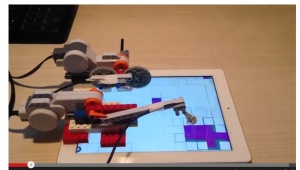Now that game auteur Peter Molyneux‘s massively mobile cube clicking game,  Curiosity -What’s Inside the Cube?, is over we are left to puzzle over its odd success. The gameplay was so mindlessly repetitive that it could be performed by a simple robot. And yet millions of people downloaded it to their iPhones and iPads and clicked away at billions of pixelated squares, and 30,000 of them were still at it almost six months after the release date when the game came to an end last Sunday. What would make a human do it? I think there were 4 main motivators.
Curiosity -What’s Inside the Cube?, is over we are left to puzzle over its odd success. The gameplay was so mindlessly repetitive that it could be performed by a simple robot. And yet millions of people downloaded it to their iPhones and iPads and clicked away at billions of pixelated squares, and 30,000 of them were still at it almost six months after the release date when the game came to an end last Sunday. What would make a human do it? I think there were 4 main motivators.
1. Curiosity. The kind that gambler’s have about the next roll of the dice. Games of chance work upon our ability to accept perform meaningless symbolic actions on the limited chance of being the winner of something valuable. It is a way to enact our human dependency on fate in a safe or sometimes dangerous environment (see Huizinga, Callois, Sutton-Smith). The game reinforced our suspended sense of satisfaction, as other gambling games and successful videogames do, by offering immediate interim reinforcement — each click revealed something underneath (see Loftus and Loftus). The big revelation was predictably disappointing, but this is not unusual in gambling (where the house always wins more than the players) or in entertainment (murder mystery solutions, TV series finales). In all these cases the enjoyment is in the moment of suspension before the revelation, and if the payoff is satisfying that is a bonus.
2. Synchronization of behavior. Because of Molyneux’s reputation many people were initially drawn to the game (250,000 by report) and the ease of participation (just click on the cubes) encouraged them to join in. Once there, they felt a part of a larger group, affiliated with a mass activity that was also a select form of affiliation. Since synchronized activity is the basis of all game pleasure (see my article, as well as Inventing the Medium, pp 13-16, and Ch 13), it is not surprising that people would want to click just to be part of this global collective activity. Clicking on the blocks was visible to the world and the larger group was visible to each individual by the speed of demolition and also the shapes forms by the demolition process.
3. Representation. As I’ve discussed elsewhere (article, ITM pp 13-16) our love of synchronization turns the characteristically human capacity for joint attention into the creation of shared forms of representation — language, writing, drawing. The process repeats itself in culture and in the cognitive/social development of babies — and also in game environments like Curiosity where players immediately turned the shared slate of a disappearing cube layer into an opportunity for passing messages and making pictures (On the Cube). Of course many of these were “rude” as the English call it, but that is also an ancient pleasure as old as graffiti.
4. Narrative. Here is Molyneux on what he learned from Curiosity:
“People told whole stories on the side of the cube. This is one harrowing but wonderful example of how people communicated. Somebody drew two skyscrapers. Someone else drew a plane crashing into the skyscrapers. Someone else drew little people falling out of windows. Someone else drew ‘God save America.’ “ (Interview with GameInformer)
The arising of narrative is not so surprising when we think of the cube as a shared medium, a global public wall, rather than a game. Given any opportunity for making a lasting inscription, humans will make use of it to tell a story.
That Molyneux chose this story may reflect the developer’s initial self-consciousness about the global nature of the project. The advertising slogan was “Can the world be brought together … to answer one question … what’s in the cube?” The answer was that large numbers of people could be orchestrated into a a synchronized effort over a period of months, and in the process they will find a way of communicating with one another, even if they can only tap on blocks. I hope the game developers retained the data about what people drew and how they responded to others’ drawings since Curiosity seems to have been a kind of mass performance piece. Molyneux and his collaborators at 22cans have been claiming that Curiosity was a research project in preparation for Godus, his next god game. So far it is certainly a huge promotional too for the new game, but it will be worth watching to see what they may have learned from it about synchronizing global communities.



Pingback: This Week in Video Game Criticism: From Man Caves to Tropes vs Women » Gaming News Alerts
Pingback: Games as Joint Attentional Scenes | Janet H. Murray's Blog on Inventing the Medium